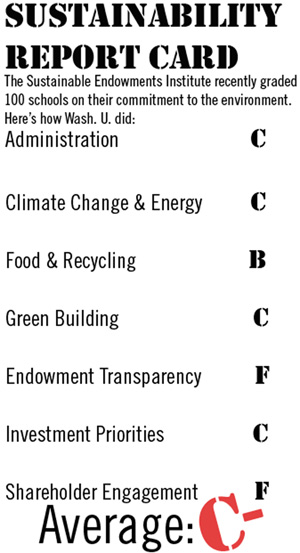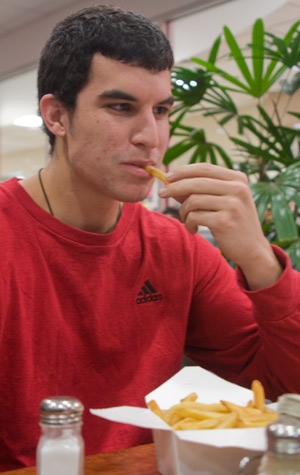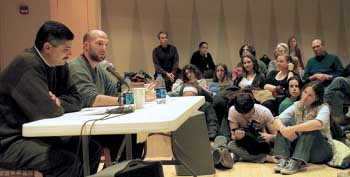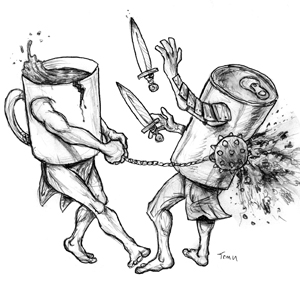
Scott Bressler
Washington University ranks below average in sustainability among its peer institutions, according to a recent study. Out of seven categories, the University earned one B, four C’s and two F’s, which average to a C-.
“The report was put together with the goal of providing clear information about different schools’ programs on sustainability on campus,” said Mark Orlowski, the executive director of the Sustainable Endowments Institute, which puts out the evaluation. “Students and administrators could refer to it as a resource to learn about what schools are doing [and] what the best practices are.”
Orlowski’s organization, which is based in Cambridge, Mass., looked at seven categories in their nationwide evaluation of 100 schools. Washington University earned a B in Food and Recycling and C’s in Administration, Climate Change and Energy, Green Building and Investment Priorities. The University earned failing grades in Endowment Transparency and Shareholder Engagement, areas that measure how the University manages its outside investments and corporate influence regarding sustainability.
James McLeod, Dean of Students, said that although the University is not where it wants to be in terms of sustainability, it is in the process of working towards that goal.
“This is a priority for us,” said McLeod. “We do have a number of initiatives going. It does take time for those things to come to fruition.”
The report said that the two F’s resulted from lack of information regarding the University’s activity in those areas, rather than from any explicit failure in policy.
“We could not find any policies or statements about this on the school Web site, and we did not receive a response [from the University],” said Orlowski. “We were only able to gather data from public sources.”
But McLeod said that the University was not sufficiently familiar with Sustainable Endowments to provide the needed figures.
“Providing information to an outside organization is not as easy as many expect it to be,” he said. “You have to be organized in a way that the organization asks. I believe this is a new venture and I could imagine that we have not organized our own data in a way that is easier to get.”
Orlowski added that those two categories reflect the school’s intention in furthering sustainability in its surrounding area, and that the University has a duty to use its local influence to propagate those initiatives.
“You have certain rights and responsibilities to use your voice towards sustainability,” he said. “We were looking to see whether the University has anything in place to act on those resolutions.”
McLeod said that the University does have mechanisms for sustainability funding in place, and that the administration is working to improve those funding plans.
“We try very hard to invest our endowment prudently and responsibly,” said McLeod. “We want to be better every day. I expect us to be more and more focused on this in the future.”
In terms of the other categories, Orlowski said that the University has made some notable accomplishments, but that there is still a wealth of untapped potential on campus.
“On the campus side, Wash. U. is doing pretty well, but there are definitely opportunities to join those other schools,” he said. “There is certainly opportunity for improvement.”
Emily Dangremond, president of Green Action, said that the intent of the study was good but that the school should be judged more strictly in terms of Food and Recycling, where it achieved its highest grade.
“There are a lot of improvements we can have in food and recycling,” said Dangremond, a junior. “We do not have the same environmental ethic as other places do. We have some really active people, and the administration is doing its part in trying to increase the amount of efficiency in building, but a lot of it is not very well publicized.”
This improvement, said Orlowski, is the goal of the survey-to give schools information about their peers’ activities so as to spread knowledge of how to best further campus sustainability.
“It is our hope to provide a measure of activity, for students and schools to understand where their peer institutions are, which schools are doing good work and which schools could use more resource and initiatives,” he said. “It is important not to focus on the grade, but on the great programs Wash. U. already has, to look at other institutions, learn from them, and adapt those programs.”
Dangremond agreed that the goal of the survey should be increased awareness, but she said that that effort cannot come only from Green Action or another individual group.
“In terms of improving the climate change and energy score, that will have to be more campus wide. That will take more than just one group,” she said.
Overall, schools scored higher in on-campus activities, and, like the University, earned lower marks in the financial categories. Orlowski attributed this tendency to on-campus activities being more visible to outside observers.
“You can see a green building, you can taste organically grown food in the dining hall, but you can’t see, touch, feel or taste an investment or an endowment. It is not visible. Those are out of sight and out of mind.”
Dangremond, however, said that she would have liked more emphasis on on-campus activity, and more evaluation of students’ efforts.
“They could have had different groups for food and recycling and maybe a category for student involvement,” she said. “The way they did it was more from the administration’s standpoint. They might as well look more at on-campus things as well.”
Despite current deficiencies, Orlowski noted that there is an upward trend in sustainability advocacy on college campuses, a pattern that should appear in next year’s report. “The trend is that there is more activity happening and excitement on campus in terms of sustainability,” he said. “It will be very exciting to see what is happening a year from now, to see the progress, the new initiatives being created.”
 Scott Bressler
Scott Bressler Scott Bressler
Scott Bressler Scott Bressler
Scott Bressler Courtesy of Barzi Goldblat
Courtesy of Barzi Goldblat Scott Bressler
Scott Bressler